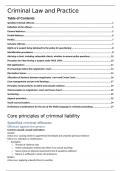Summary
Summary SQE 1 - Criminal Law and Practice Revision Notes (FLK 2)
- Course
- Institution
Passed Jan 2024 SQE 1 first try (1st Quintile) using these notes. Summarises everything you need to know for Criminal Law and Practice, including the core knowledge of Criminal law. Carefully curated summary notes, aligned precisely with SRA guidelines, comprehensive and also tailored to the speci...
[Show more]



